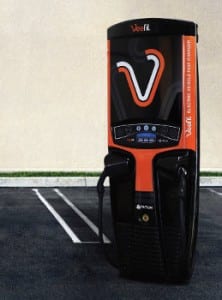Electric Vehicle Fast Charger From Australia Makes It To Europe
Originally published on Renew Economy.
By Sophie Vorrath
An award-winning Australian-designed electric vehicle fast charger will make its European debut at the Intersolar 2014 conference in Munich this week, kicking off a new commercial deal for the technology .
Queensland EV systems manufacturer Tritium will unveil its groundbreaking Veefil fast charge technology at the huge solar conference as part of a collaboration with Shanghai-based electrics manufacturer, SSE, that will see the chargers produced at volume and distributed globally.
Tritium, a Brisbane-based company that evolved from developing solar racing powertrains, launched its Veefil charging system in May 2013, boasting the ability to charge an EV 20 times faster than plugging it into the wall at home, and to add 50km range to an EV battery in just 10 minutes.
The charging system – developed over 10 years and backed by a $1.15 million Early Stage Commercialisation grant –last month won a Good Design Award, beating out products like the Audi A3 sedan and the new Melbourne e-class tram.
As well as its fast charging capabilities, the units are small and light-weight, can function in below-zero temperatures, and are relatively easy to install in locations most convenient for EV drivers, including airports, coffee shops, service and shopping centres.
“This is the coming together of a high- performance product with a high-quality manufacturing capability. The intention of the partnership is to address the cost barriers that currently exist in the electric vehicle charging market, without compromising on the quality of the product,” said Tritium managing director, David Finn.
“Having designed Veefil from the ground up, Tritium has full control of all product components, presenting a unique opportunity to take advantage of SSE’s extensive experience in power electronics manufacturing.”
Have a tip for CleanTechnica? Want to advertise? Want to suggest a guest for our CleanTech Talk podcast? Contact us here.
Latest CleanTechnica.TV Video

CleanTechnica uses affiliate links. See our policy here.
